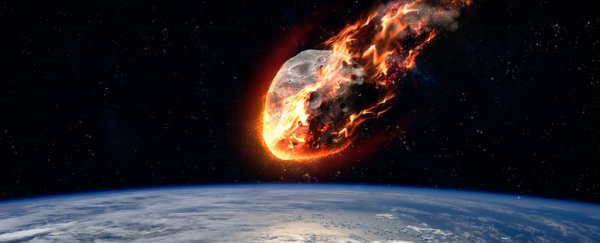NASA has established a new body to oversee its ongoing efforts to detect and track near-Earth objects (NEOs). The Planetary Defence Coordination Office (PDCO) will control all NASA-funded projects to identify and analyse any asteroids or comets that pass near Earth's orbit around the Sun.
And that's a lot of sky traffic to supervise. Since NASA-funded surveys started to watch for asteroids and comets in 1988, more than 13,500 NEOs have been discovered, and that tally is increasing at a rate of approximately 1,500 per year. Most of these we don't hear about, but some definitely come a little close for comfort.
" Asteroid detection, tracking and defence of our planet is something that NASA, its interagency partners, and the global community take very seriously," said John Grunsfeld, associate administrator for NASA's Science Mission Directorate in Washington. "While there are no known impact threats at this time, the 2013 Chelyabinsk super-fireball and the recent 'Halloween Asteroid' close approach remind us of why we need to remain vigilant and keep our eyes to the sky."
Astronomers have already located more than 90 percent of NEOs larger than 1 kilometre long (3,000 feet) via telescopic surveys of the sky, with the focus now shifting to smaller objects of around 140 metres (450 feet) in length, or about the size of a football field. These NEOs, though significantly smaller than the larger objects, could still pose a considerable risk in the event of an impact, and NASA has given itself the task of detecting 90 percent of this smaller class by the end of the decade.
NASA's new defence office comes at a time when awareness of the potential threats posed by NEOs is perhaps higher than ever. Last year, a consortium of more than 100 scientists and artists joined forces to raise awareness for Asteroid Day, a global movement designed to educate the public on the risks of NEO impacts and ramp up pressure on governments to increase efforts (much like the PDCO).
But this kind of popular awareness has a downside too, with viral hoaxes announcing threats when there aren't any, obliging NASA to step in and clarify the situation.
Fortunately, the PDCO will help set the record straight in the future – in addition to monitoring potentially hazardous objects, the office will work to keep the public informed of the latest NEO science data, issuing notices on things like close passes and warning when NASA has detected potential impacts.
In the event of the latter, the PDCO will work with other US government bodies including the Federal Emergency Management Agency (FEMA) and international counterparts to help coordinate responses to any actual impact threats.
"The formal establishment of the Planetary Defence Coordination Office makes it evident that the agency is committed to perform a leadership role in national and international efforts for detection of these natural impact hazards, and to be engaged in planning if there is a need for planetary defence," said Lindley Johnson, NASA's newly named Planetary Defence Officer (and sorry, but that job title is way cooler than yours).
The long-term goal in planetary defence is to develop Armageddon-style technological measures to deflect or redirect NEOs bound for a collision with Earth. One such method could be NASA's Asteroid Redirect Mission, a robot-based concept that aims to create a kind of gravity tractor, using the mass of a boulder collected from an asteroid to divert it from its original orbit path.
If such emergency measures don't pan out in the event of an impact threat, NASA would work with FEMA and its counterparts to inform them on precise impact timing, location, and effects to help with response operations.
"FEMA is dedicated to protecting against all hazards," said FEMA administrator Craig Fugate, "and the launch of the coordination office will ensure early detection and warning capability, and will further enhance FEMA's collaborative relationship with NASA."
We feel safer already.
